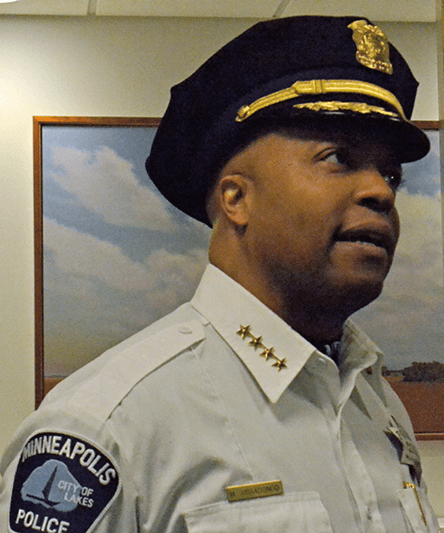The new head of the Minneapolis Police Department is humble (“I grew up in a family of nine kids. We all took turns cleaning the toilet. You learn humility in a hurry.”)…And realistic (“The average shelf life for a big-city chief of police is three years.”). But that won’t stop Medaria Arradondo from trying to change the culture of MPD.
“Rondo” spoke Nov. 24 at the Minneapolis Chamber of Commerce public policy forum about his background and his plans for the future. Standing before the group in an impeccably crisp uniform, he said, “This city has shaped me, and my values.” The city’s first black police chief grew up in South Minneapolis, where his parents taught him not to let his race hold him back.
He said morale in MPD, which celebrated its 150th year of service this year, is low. “We’ve done a lot of wonderful things in 150 years,” he said. “We’ve also caused harm.”
While he can’t change the past, he knows he wants to change the future. He knows cultural change won’t come easy. “Cops can be funny,” he said. “Some hate change and want to keep things the way they are. Others are fine with it.”
The department is moving ahead with procedural justice training. “The vast majority of our encounters with the public don’t require the use of force,” Arradondo said. “Using de-escalation techniques and providing people a chance to tell their side of the story can improve communication and make relationships stronger. Everyone – people and cops – has to come home at night.”
Procedural justice focuses on relationships. “Everyone has a life story. I try to listen as actively as I can,” the chief said.
Trust is a key element. “If a community doesn’t trust the police, they don’t see them as legitimate,” he said. He mentioned the Fulton neighborhood, where Justine Damond was killed by officer Mohamed Noor. “Trust in the Fulton neighborhood has become jaded,” he said. “We have to be accountable to communities and to each other.”
Part of the procedural justice training means meeting people on their own turf. For example, the department found that members of Hispanic communities were less likely to call police about crimes in their neighborhoods. “They were afraid that reporting a burglary could lead to deportation.”
He’s also looking after the force’s health. Police work is often traumatic, he said, and “for the first time, we’re naming it and teaching its impact to officers.” He cited a scientific study of rats that were subjected to a puff of smoke, then an electrical shock. After a time, the rats would react to the smoke as if they had been shocked. Subsequent generations of rats showed the same response to smoke, even though they had never been given an electrical shock. Police officers exposed to trauma time and again, pass that anxiety to others in the department.
Changing the culture also extends to other areas, such as the 911 call center. “We receive half a million 911 calls a year,” Arradondo said. “Callers don’t distinguish between the operators and the police.” Calls to the center are prioritized by urgency. “When someone calls in ‘suspicious activity,’ operators now ask, ‘What makes them suspicious?’ and try to get more details.”
Asked about Mayor-elect Jacob Frey’s recent move to expand the police force, Rondo replied, “Having a cop on every block doesn’t reduce crime. Police work is becoming more than arresting bad guys. Fifty percent of the inmates in Hennepin County jail have a history of mental illness. We need to tap into the public health sector to deal with that. We [the city] have to address jobs and housing.”
Questioned about the chief’s relationship with the police union, he said, “There’s a separation between unions and chiefs. The union doesn’t guide the mission and vision of the department.”
Arradondo said two of his long-term goals are the reduction of gun violence in the city, and putting a lid on heroin/opioid use.
In the short-term, he anticipates trouble when a decision is handed down by County Attorney Mike Freeman on the Justine Damond case. If Noor is prosecuted, he said, the black community could see it as a black man being punished for harming a white woman. If he isn’t prosecuted, the white community could see it as a failure of justice for Damond. Either way, “it will have an impact on the city. Race is in the forefront and the background of what we do.”
Arradondo says he is up for the challenge though he admits, “I’m trying to create actions that I may never see the outcome. Ten to 20 years from now, we’ll have a better community and better policing.”
Below: Chief Medaria Arradondo (Photo by Cynthia Sowden)
